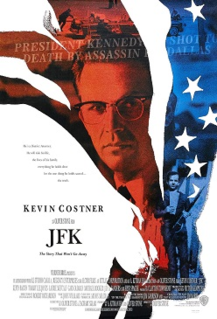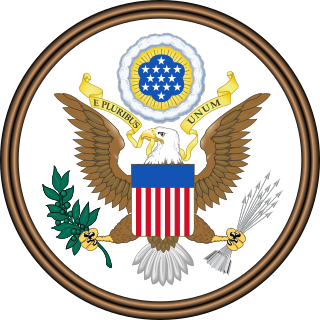Related Research Articles

JFK is a 1991 American epic political thriller film that examines the events leading to the assassination of John F. Kennedy in 1963 and alleged cover-up through the eyes of former New Orleans district attorney Jim Garrison. Garrison filed charges against New Orleans businessman Clay Shaw for his alleged participation in a conspiracy to assassinate Kennedy, for which Lee Harvey Oswald was found responsible by the Warren Commission.

The President's Commission on the Assassination of President Kennedy, known unofficially as the Warren Commission, was established by President Lyndon B. Johnson through Executive Order 11130 on November 29, 1963, to investigate the assassination of United States President John F. Kennedy that had taken place on November 22, 1963. The U.S. Congress passed Senate Joint Resolution 137 authorizing the Presidential appointed Commission to report on the assassination of President John F. Kennedy, mandating the attendance and testimony of witnesses and the production of evidence. Its 888-page final report was presented to President Johnson on September 24, 1964, and made public three days later. It concluded that President Kennedy was assassinated by Lee Harvey Oswald and that Oswald acted entirely alone. It also concluded that Jack Ruby acted alone when he killed Oswald two days later. The Commission's findings have proven controversial and have been both challenged and supported by later studies.

The United States House of Representatives Select Committee on Assassinations (HSCA) was established in 1976 to investigate the assassinations of John F. Kennedy and Martin Luther King, Jr. in 1963 and 1968, respectively. The HSCA completed its investigation in 1978 and issued its final report the following year, which concluded that Kennedy was probably assassinated as a result of a conspiracy. In addition to now-discredited acoustic analysis of a police channel dictabelt recording, the HSCA also commissioned numerous other scientific studies of assassination-related evidence that corroborate the Warren Commission's findings.

Santo Trafficante Jr. was among the most powerful Mafia bosses in the United States. He headed the Trafficante crime family and controlled organized criminal operations in Florida and Cuba, which had previously been consolidated from several rival gangs by his father, Santo Trafficante Sr.
Ruth Hyde Paine was a friend of Marina Oswald, who was living with her at the time of the JFK assassination. According to four government investigations, Lee Harvey Oswald stored the 6.5 mm caliber Carcano rifle that he used to assassinate U.S. President John F. Kennedy in Ruth Paine's garage, unbeknownst to her and her husband, Michael Paine.
Robert Booker Baer is an American author and a former CIA case officer who was primarily assigned to the Middle East. He is Time's intelligence columnist and has contributed to Vanity Fair, The Wall Street Journal, and The Washington Post. Baer speaks eight languages, won the CIA Career Intelligence Medal and is a frequent commentator and author about issues related to international relations, espionage, and U.S. foreign policy. He hosted the History reality television series Hunting Hitler. He is an Intelligence and Security Analyst for CNN. His book See No Evil was adapted by the director Stephen Gaghan and used as the basis for the film Syriana, with George Clooney playing Baer's character.
The Nazi War Crimes and Japanese Imperial Government Records Interagency Working Group is a United States government interagency group, which is tasked with locating, identifying, inventorying, and recommending for declassification classified U.S. records relating to Nazi German and Imperial Japanese war crimes.
David Atlee Phillips was a Central Intelligence Agency officer of 25 years and a recipient of the Career Intelligence Medal. Phillips rose to become the CIA's chief of operations for the Western hemisphere. In 1975 he founded the Association of Former Intelligence Officers (AFIO), an alumni association comprising intelligence officers from all services.
John Pleshette is an American actor and screenwriter, best known for his role as Richard Avery on the television drama Knots Landing, and for portraying Lee Harvey Oswald in the TV movie The Trial of Lee Harvey Oswald. Pleshette also wrote several scripts for Knots Landing in the 1980s.

On March 1, 1967, New Orleans District Attorney Jim Garrison arrested and charged New Orleans businessman Clay Shaw with conspiring to assassinate President Kennedy, with the help of Lee Harvey Oswald, David Ferrie, and others. On January 29, 1969, Shaw was brought to trial in Orleans Parish Criminal Court on these charges. On March 1, 1969, a jury took less than an hour to find Shaw not guilty. It remains the only trial to be brought for the assassination of President Kennedy.
Yuri Ivanovich Nosenko was a KGB officer who defected to the United States in 1964. Controversy arose in the CIA over whether he was a bona fide defector and he was held in detention for over three years before he was finally accepted as a legitimate defector by the CIA. After his release, he became an American citizen, working as a consultant and trainer for the CIA.
The John F. Kennedy assassination and the subsequent conspiracy theories surrounding it have been discussed, referenced, or recreated in popular culture numerous times.
Gerald Patrick "Gerry" Hemming, Jr. was a former U.S. Marine, mercenary and Central Intelligence Agency asset within the Domestic Contact Division beginning in 1960, using the aliases Jerry Patrick, Gerry Patrick, Heming and Hannon. He was primarily involved in covert operations against Cuba.

The President John F. Kennedy Assassination Records Collection Act of 1992, or the JFK Records Act, is a public law passed by the United States Congress, effective October 26, 1992. It directed the National Archives and Records Administration (NARA) to establish a collection of records to be known as the President John F. Kennedy Assassination Records Collection. It stated that the collection shall consist of copies of all U.S. government records relating to the 1963 assassination of President John F. Kennedy, and that they are to be housed in the NARA Archives II building in College Park, Maryland. The collection also included any materials created or made available for use by, obtained by, or otherwise came into the possession of any state or local law enforcement office that provided support or assistance or performed work in connection with a federal inquiry into the assassination.

Claimed coincidences connecting U.S. Presidents Abraham Lincoln and John F. Kennedy are a piece of American folklore of unknown origin. The list of coincidences appeared in the mainstream American press in 1964, a year after the assassination of John F. Kennedy, having appeared prior to that in the GOP Congressional Committee Newsletter. Martin Gardner examined the list in an article in Scientific American, later reprinted in his book, The Magic Numbers of Dr. Matrix. Gardner's version of the list contained 16 items; many subsequent versions have circulated much longer lists. The list is still in circulation today, having endured in the popular imagination for over 50 years. In 1992, the Skeptical Inquirer ran a "Spooky Presidential Coincidences Contest." One winner found a series of sixteen similar coincidences between Kennedy and former Mexican President Álvaro Obregón, while the other came up with similar lists for twenty-one pairs of U.S. presidents.
The CIA Kennedy assassination theory is a prominent John F. Kennedy assassination conspiracy theory. According to ABC News, the Central Intelligence Agency (CIA) is represented in nearly every theory that involves American conspirators. The secretive nature of the CIA, and the conjecture surrounding high-profile political assassinations in the United States during the 1960s, has made the CIA a plausible suspect for some who believe in a conspiracy. Conspiracy theorists have ascribed various motives for CIA involvement in the assassination of President Kennedy, including Kennedy's firing of CIA director Allen Dulles, Kennedy's refusal to provide air support to the Bay of Pigs invasion, Kennedy's plan to cut the agency's budget by 20 percent, and the belief that the president was weak on communism.
John M. Newman is an American author and retired major in the United States Army. Newman was on the faculty at the University of Maryland from 1995 to 2012, and has been a Political Science professor at James Madison University in Harrisonburg, Virginia since January 2013.

The assassination of John F. Kennedy on November 22, 1963, and the murder of Lee Harvey Oswald by nightclub owner Jack Ruby spawned numerous conspiracy theories. These theories allege the involvement of the CIA, the Mafia, Vice President Lyndon B. Johnson, Cuban Prime Minister Fidel Castro, the KGB, or some combination of these entities. The original FBI investigation and Warren Commission report, as well as an alleged "benign CIA cover-up", have led to the claim that the federal government deliberately covered up crucial information in the aftermath of the assassination. Former Los Angeles District Attorney Vincent Bugliosi estimated that a total of 42 groups, 82 assassins, and 214 people had been accused at one time or another in various conspiracy scenarios.

Directorio Revolucionario Estudiantil was a Cuban student activist group which in opposition to Cuban dictator Fulgencio Batista from 1954 to 1957 played a role in the Cuban Revolution, which came to power in 1959. In 1960, the Directorio was relaunched in opposition to Fidel Castro and moved its base to the United States, where it soon developed links with the Central Intelligence Agency. In August 1962 it carried out an attack on a beachfront Havana hotel. As of 1963, it was the largest anti-Castro student group in Miami; it also had a chapter in New Orleans, where it had contact with Lee Harvey Oswald in mid-1963. Immediately after the 22 November 1963 assassination of John F. Kennedy, it launched a campaign asserting that Lee Harvey Oswald had been acting on behalf of the Cuban government. The group lost its CIA support in December 1966.
John Moss Whitten (1920–2000) was an American Central Intelligence Agency officer, known under the pseudonym John Scelso. He was awarded the Distinguished Intelligence Medal in 1970.
References
- ↑ "JFK Declassified: Tracking Oswald". History. Retrieved July 23, 2017.
- ↑ "JFK Declassified: Tracking Oswald, Full Cast & Crew". IMDb. Retrieved July 23, 2017.
- ↑ Olivia B. Waxman (April 25, 2017). "Former CIA Operative Argues Lee Harvey Oswald's Cuba Connections Went Deep". Time.